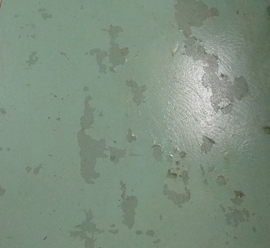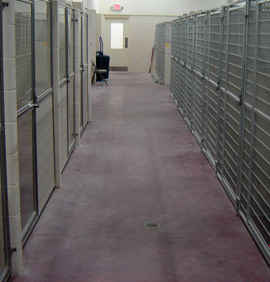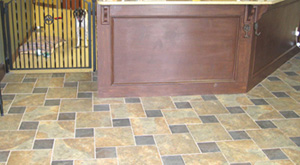
Four Factors for Flooring Success
Part 1: Suitability and Quality of Materials
By Grant Loyd
Avoiding costly and irritating flooring problems is a major issue for operators of animal care facilities. Our society is conditioned to expect simple, quick solutions for almost everything. Consequently, people suppose (or hope) there is a simple, quick (and cheap) solution to avoid flooring problems. Unfortunately, it doesn't work that way. The most important fact to remember is that flooring "success" is not a simple matter.
Successful flooring results depend on these factors: 1) suitability and quality of the materials, 2) proper floor preparation, 3) proper installation, and 4) proper maintenance. These four items will serve as an outline for this series of articles on dealing with flooring in your boarding and daycare facility.
Now we're ready to move into more specific information that will help you ensure your bottom line is improved by avoiding costly, irritating problems with flooring. Let's begin by looking at suitability and quality of materials.
Suitability
Animal care facilities have a set of requirements for flooring, which is different than your typical residential or commercial flooring. Therefore, not all available floor options are necessarily going to produce the best results for boarding and daycare facilities, particularly in areas where animals live. Typical residential or commercial options may be appropriate in your office areas, reception/retail areas, or bathrooms but would perform poorly in enclosures, enclosure aisles, or play areas.

Before installation, consider if your flooring option is suitable for kennels. Paint usually will not hold up on a kennel floor.
Common sense indicates needing a level, smooth floor that is seamless, not slippery (not too smooth), easily cleanable (not too rough), non-absorbent, able to resist abrasion of dog nails, and resistant to water, urine, and chemicals. If you apply those criteria, then you might, for example, eliminate vinyl composition tile (VCT) and typical vinyl sheet goods, as well as many types of tile with grout lines, particularly in the working areas of facilities.
The idea of suitability includes more than just the appropriateness of types of flooring. Consideration of suitability should include uses recommended by the manufacturer. Most flooring options, whether fluids (e.g. paint, epoxy, acrylics, stains) or floor coverings, are designed and manufactured for use in specific environments where they are expected to perform well under typical use. If products are introduced into an environment having different conditions than recommended, you can expect problems.
Your best safeguard is to check with the manufacturer to make sure the product you are considering is recommended for use in your environment. Data sheets provided by manufacturers can be found online for almost all products, or you can call the manufacturer directly and ask about your specific application.

VCT tile has joints through which urine can penetrate, creating odor and sanitary problems. This tile had to be removed and the floor redone because the odor was very strong.
Be wary of relying on information from installers or retailers. It's not that they would purposefully mislead, but often their main objective is to sell you what they have. They may recommend the type of floor they install in other venues as opposed to kennels specifically.
They are also a step removed from ultimate responsibility. Manufacturers, on the other hand, have a bigger investment in people only using their products appropriately. Since they make the flooring, they want to maximize the success and eliminate complaints or failures.
While animal care facilities have high-demand needs related to flooring, few flooring manufacturers develop and make products specifically for those needs. The question in most cases will be, "Does the manufacturer recommend the specific product for installation in animal care facilities?"

The VCT tile was replaced with a seamless, full-chip epoxy floor and a durable polyurea clear coat, a suitable choice that eliminated the odor and contamination problem.
It is wise to check with the manufacturer whether you are installing it yourself or hiring a contractor to do the work for you. Obviously, just because the manufacturer recommends using their product in kennels, it doesn't mean you will have a successful experience with it. Remember that success depends on all four factors - not just one. However, if a manufacturer does not or will not recommend a particular product for use in kennels, then you should take them at their word.
You might want to refer back to "The Best Flooring for your Pet Care Facility" in the January 2012 issue of Pet Boarding & Daycare. The article includes a picture of a popular brand of concrete sealer made by a major paint company. While that product would likely work very well in the basement of your home, you can see the result when put in a dog kennel.
Quality of Materials
Coatings, sealers, epoxies, urethanes, stains, and floor coverings are like everything else. Some are good. Some are bad. Some are in between. While price alone is not a rule without exception, you generally get what you pay for.

Penetrating sealers over integrally colored concrete eliminates peeling in high use areas.
As noted in the previous article, it is important to understand how the maxim "only rich people can afford to use cheap paint" applies to running a kennel. In the case of fluid flooring (i.e. putting a liquid product on the floor instead of "floor coverings" like carpet, vinyl, rubber, tile, etc.), the actual materials will be a small part of the overall cost of the job. If you try to save a few bucks by purchasing the cheaper material, you will greatly increase your risk of losing several times that amount of money if you are forced to close down and redo that failed floor.
Concrete is a difficult substrate to protect due to moisture and chemistry issues. While you might get by with cheap paint in your home's bedroom, the chances of an acceptable result using the cheapest alternative on concrete in a kennel are remote. Don't get caught being "penny wise and pound foolish."
Caveat Emptor
Buying sealers and coatings for flooring is definitely an exercise in "let the buyer beware." Unfortunately, the Internet gives ready access to all kinds of entrepreneurs. It seems that the coatings industry, particularly the decorative concrete area, is prone to exaggerated sales claims by those hoping to make easy money. Many have jumped on board the "beautify and protect concrete" train by introducing all kinds of products supported by slick advertising and deceptive warranty claims. There is no substitute for due diligence.

While tile joints cause problems in working areas, tile can be used in upscale reception areas to create ambience without creating too much of a cleaning problem. Notice that behind the gate, the dog is standing on a seamless surface, because that is a working area.
Finally, a "buyer beware" warning pertaining to local sources. "Mass marketed" coatings, paint, and sealers are just not going to work very well. As a rule, products on the mass market are developed for identified "price point" windows. Advertising kicks in to increase market share at that price point. In other words, the driving force is not someone developing a good product and then marketing a quality, high-performing material. Instead, it is about price point to appeal to price-shopping consumers.
It even gets stickier than this. A common element in the advertising designed to move those products off the shelf is "making the product sound easy to use." You are enticed to believe Product X is really easy to apply while minimizing necessary prep work. Just put 'er down. This is a trap you want to avoid. Without going into more supporting details, let me assure you that this is how it works on the average. There are exceptions. Some high-performance products are easy to apply, but you are unlikely to find them in the mass market.
Here is a little side note on "high-performance" sealers or coatings. Coatings and sealers can be categorized into two groups: one-component (1K) and two-component (2K) products. Materials that are 1K are ready to use right out the container. Most household paint is 1K. Just open the can and put it on. Material that is 2K consists of an activator or hardener component in addition to the main ingredient component. To use this type of material, you mix a portion of the two components together in the specified ratio before using, like you do with epoxy, for example.
One component products are usually easier to use (no mixing of ingredients), and they typically get hard by drying. Two component materials, which have a Part A and Part B that you mix before using, are usually a little more complicated to apply. They don't dry; instead they cure by chemical reaction, so you have to get all the product applied before the end of the "pot life" or working time.
It is rare to find good quality two-component (2K) sealers or coatings on the mass market. While you can find 2K epoxy kits in big box stores, they generally perform poorly in kennel applications. As a general rule in the coatings industry, two-component products will almost always provide higher performance and durability than one-component products.
To be blunt, my advice is this: do not buy coatings, sealers, or decorative concrete materials (including epoxy) from a big box store. Although you might get an acceptable result, you have a greater risk of encountering a failure that can be catastrophic if you have to close your facility and redo your floors.
A second tip: if you go to a major paint or coatings manufacturer (like Sherwin Williams or Benjamin Moore), avoid buying products out of their residential divisions. Most big paint and coatings manufacturers develop and sell products based on target markets. Products in their industrial or commercial divisions will typically outperform those in their residential divisions. Usually you will pay more, but you will likely get a product that was developed to withstand worse treatment and perform better than the residential grade products.
In summary, to get good results from your flooring endeavors, you must pay attention to all four of the factors identified above. Making sure that the product you select is endorsed by the manufacturer for use in animal care facilities AND making sure you buy a quality product will put you two steps further down the road to solving or avoiding costly flooring problems.
In the next issue, we will look at the importance of Factor #2: floor preparation.
Grant Loyd is the owner of DogKennelFloors.com and SolvingConcreteProblems.com. He has specialized in animal care facility flooring for 11 years and in concrete protection, including decorative concrete options and coatings, for 20 years.


